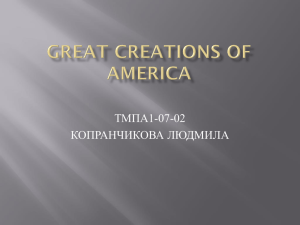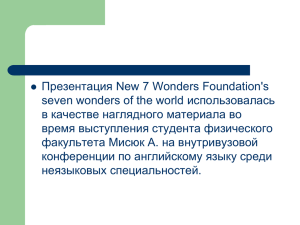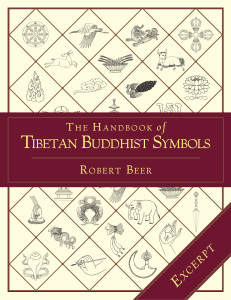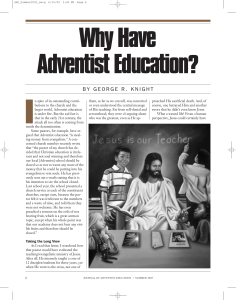Взаимоотношения реликвий и образов в буддистской и
advertisement
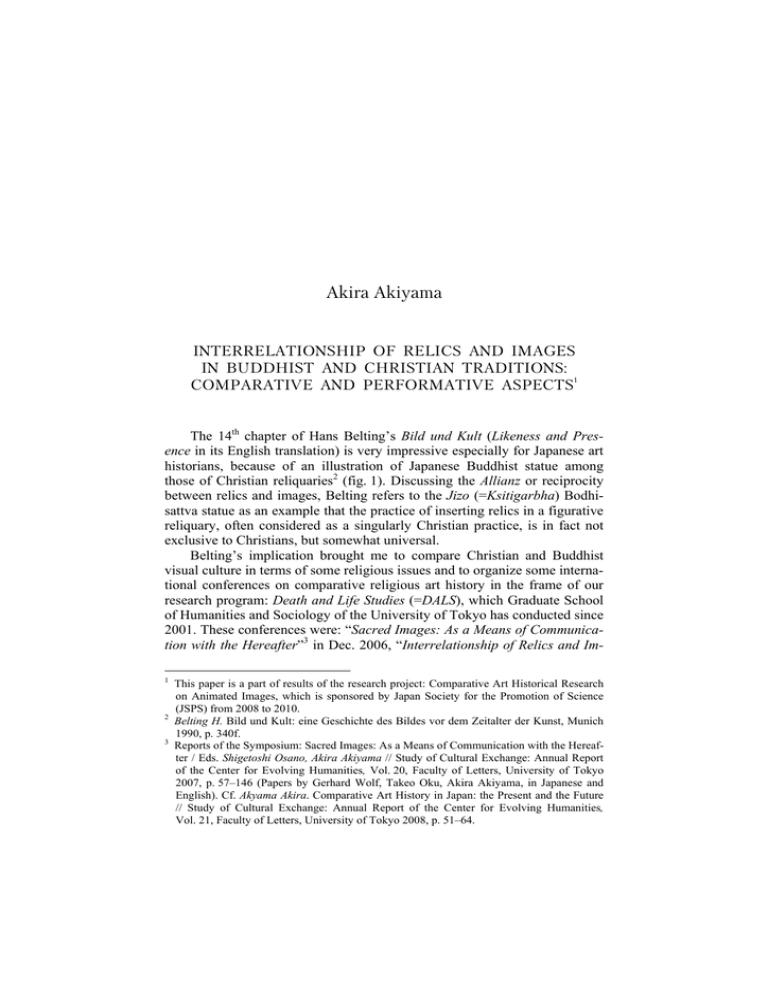
Akira Akiyama INTERRELATIONSHIP OF RELICS AND IMAGES IN BUDDHIST AND CHRISTIAN TRADITIONS: COMPARATIVE AND PERFORMATIVE ASPECTS1 The 14th chapter of Hans Belting’s Bild und Kult (Likeness and Presence in its English translation) is very impressive especially for Japanese art historians, because of an illustration of Japanese Buddhist statue among those of Christian reliquaries2 (fig. 1). Discussing the Allianz or reciprocity between relics and images, Belting refers to the Jizo (=Ksitigarbha) Bodhisattva statue as an example that the practice of inserting relics in a figurative reliquary, often considered as a singularly Christian practice, is in fact not exclusive to Christians, but somewhat universal. Belting’s implication brought me to compare Christian and Buddhist visual culture in terms of some religious issues and to organize some international conferences on comparative religious art history in the frame of our research program: Death and Life Studies (=DALS), which Graduate School of Humanities and Sociology of the University of Tokyo has conducted since 2001. These conferences were: “Sacred Images: As a Means of Communication with the Hereafter”3 in Dec. 2006, “Interrelationship of Relics and Im1 2 3 This paper is a part of results of the research project: Comparative Art Historical Research on Animated Images, which is sponsored by Japan Society for the Promotion of Science (JSPS) from 2008 to 2010. Belting H. Bild und Kult: eine Geschichte des Bildes vor dem Zeitalter der Kunst, Munich 1990, p. 340f. Reports of the Symposium: Sacred Images: As a Means of Communication with the Hereafter / Eds. Shigetoshi Osano, Akira Akiyama // Study of Cultural Exchange: Annual Report of the Center for Evolving Humanities, Vol. 20, Faculty of Letters, University of Tokyo 2007, p. 57–146 (Papers by Gerhard Wolf, Takeo Oku, Akira Akiyama, in Japanese and English). Cf. Akyama Akira. Comparative Art History in Japan: the Present and the Future // Study of Cultural Exchange: Annual Report of the Center for Evolving Humanities, Vol. 21, Faculty of Letters, University of Tokyo 2008, p. 51–64. 644 Akira Akiyama ages in Christian and Buddhist Culture”4 in Dec. 2007 and “Miraculous Images in Christian and Buddhist Culture”5 in May 2008. Through these occasions it has become clear that there are many common elements between Christian and Buddhist art history, as we had thought before. For example, theoretically a cult image must be a representation of the prototype. However, like in Christian culture, also in Buddhist culture there were plenty of cult images of the same Buddha or deity and each lived seemingly its own life. At least it is able to say that people were and are often still inclined to believe their cult image was “living”. Now I am confident of the mutual discussion between experts in Christian art history and those in Buddhist art history will be able to bring more fruitful results for each field, if they can discuss on common theme, particularly from aspects of religious functions of images. In this paper I would like to try to compare two issues in Christian and Buddhist figurative culture, namely, relic insertion and dressing/undressing the statue, which are becoming gradually popular themes in both fields. *** In early phase of Buddhism in Japan there were many of miraculous statues like acheiropoietos, images not made by human hands, or quasiacheiropoietos, whose origin were mythical. However, as demand for the statue increased, people needed means to animate the newly made statues. A typical means to animate the statue was to insert relics, human remains or other objects into the statue made of wood. According to legends, in India King Asoka’s fourth daughter made relic insert into a statue of Buddha. In 7th century China it was said that the statues brought from the western countries, India or Central Asia, emitted radiant light, because of Buddha’s relic inside of them. This kind of belief was imported also into Japan. The earliest example of the placement of relics of Buddha into Buddhist statuary in Japan dates to the early 8th century. 4 5 Interrelationship of Relics and Images in Christian and Buddhist Culture / Eds. Akira Akiyama, Kana Tomizawa (Kitazawa). University of Tokyo 2009 (Papers by Erik Thuno, Scott B. Montgomery, Romi Hida, Kensuke Nedachi, Akira Akiyama). Miraculous Images in Christian and Buddhist Culture / Eds. Akira Akiyama, Kana Tomizawa (Kitazawa). University of Tokyo 2009 (Papers by Akira Akiyama, Ryusaku Nagaoka, Ivan Gaskell, Makoto Kasuya, Gerhard Wolf, Tetsuya Ohtoshi, Takeo Oku). As the fourth symposium: Animated Images in Christian and Buddhist Culture was held on 16 May, 2010 with Michele Bacci, Michitaka Suzuki, Takeo Oku and Kyoko Sengoku-Haga, as the fifth: Image and Vision in Christian and Buddhist Cultures on 13 Feb. 2011 with Herbert Kessler, Michele Bacci, Fabio Rambelli, Ryusuke Masuki, Motokazu Kimata and Seinoruke Ide. Proceedings of these symposia will be published in near future. Interrelationship of Relics and Images in Buddhism and Christianity 645 A representative example for this phenomenon is a statue of Sakyamuni in Seiryo-ji temple, Kyoto6 (fig. 2), which is 162.6 cm high. This statue is reputedly a copy of the very first Statue of Sakyamuni, which an Indian King Udayana commissioned7. During absence of Sakyamuni, who had went to the heaven in order to preach to his mother, the King Udayana became ill and he commissioned for his remedy a portrait statue of Sakyamuni. According to a legend, as Sakyamuni came back, the statue made a bow to him. It is said that the original statue was made of camphor wood and about 150 cm high. Later, the statue was allegedly brought by an Indian monk Kumārayana from India to Kucha, a Central Asian Kingdom, and then by his son Kumārajīvaa to China. As a Japanese priest Chonen visited China in 983–986, he commissioned a copy of this legendary Buddha statue of King Udayana, which was then preserved in the Emperors Palace in Kai-feng. Two Chinese Sculptors produced the copy, most probably from a drawing of the original. The documents, found from the cavity of the statue, proves that the statue in Seiryo-ji temple is the very statue, which Chonen brought back to Japan in 987. Later in Japan, this statue was believed as the original portrait-statue of Sakyamuni, because Chonen exchanged the original with its copy under the instruction from the original statue itself, which had emerged in his dream. This version of legend was distributed widely within Japan through narratives, legend collections and painted scrolls. The statue of Seiyo-ji temple is made of cherry wood (in Latin: Prunus wilsonii koehne) and sarira, relics of Sakyamuni, which were in Japan normally tiny balls of gold, silver, crystal or pearl instead of the actual bones, were inserted besides many other objects such as copper or nickel mirrors with an engraved figures (fig. 3), some Buddhist prints (fig. 4), copies of sutras, a list of donors or petitioners (fig. 5) etc. Most interesting is the model of organs made of silk (fig. 6), in which relics were put. These guts with relics and mirrors were believed to make the statue animated or “living”. As a tooth relic of Sakyamuni was inserted into the mouth of this statue during its production (fig. 7), it is told that a red spot appeared on the upper back of it. This is indicative of the belief that the insertion of the relic caused the statue to be filled with life. As this case indicates, relic insertion is apparently a means to animate an image at the time of its consecration in East Asian Buddhism. It makes the statue “living” and miracu6 7 Nihon Chokoku-shi Kiso Shiryo Shusei, Heian Jidai, Zozomeiki-hen (=Basic Documents of History of Japanese Sculpture, Heian Period), Vol. 1, Tokyo1966, p. 42–65 (in Japanese); Takeo Oku, Seiryo-ji Shakanyorai-zo (=Sakyamuni Statue of Seiryo-ji Temple in Kyoto), Tokyo 2009 (in Japanese). Yasuo Inamoto. Uten-o zo touden ko (On the Propagation of the Buddha Image of King Udayana to the East // Toho Gakuho, 69, 1997, p. 357–466 (in Japanese). 646 Akira Akiyama lous. In this aspect an episode on the Cross of Gero, the Gerokreuz (fig. 8), in the Cologne Cathedral is worth to be referred. According to Thietmar of Merseburg, when a crack was found in the head of the crucified, a consecrated host was laid into it as a substitution of relics, and then the crack disappeared miraculously8. However, in the Christian Middle Ages relic insertion principally functioned rather to distinguish Christian cult image with pagan idols, and not as a means of animating the statues. As Irene Forsyth pointed out, often it was even forgotten in the Christian Middle Ages that relics had been inserted into the statue9. The case of the statue of Sakyamuni in Seriyo-ji temple shows the relic insertion was indispensable at the time of its production and consecration, but after that no one was allowed to open the lid on the back of the cavity (fig. 9) and the fact, that the relics and other objects were inserted was, most probably forgotten gradually. So, before the academic investigation, which was took place in 1954, nobody had imagined that so many objects were in the cavity of the statue. Nevertheless this statue has been recognized reputedly as the original statue of the living Buddha and people has believed it would move or fly. Thanks to legends and narratives this statue could keep its status as a “living” statue. During the translation of the statue from India to Central Asia an uncommon miracle occurred. As Kumārayana, father of Kumārajīvaa, was so tired at night because of carrying the statue on his back, the statue in turn carried him on its back and walked. This episode of the translation of the statue is well known in Japan and was illustrated in the painted scrolls of the origins and history of Seiryo-ji temple (fig. 10). According to a Buddhist narrative, Hobutsushu (=Collection of treasures), from the late 12th century, people were once afraid that the statue would fly back to India because of the political and social unstableness in Japan10. Because this statue was regarded as a miraculously animated statue, many copies were made and distributed in all over Japan, many of which, more than one hundred remains today. By the way, the relic insertion in Japan became popular since Kamakura-period, late 12th century. A typical example is the so-called Great Buddha statue of Todai-ji temple in Nara, which is about 15m high, the largest Buddha statue preserved in Japan. After the fire at Todai-ji, the deeply dam8 Wolf G. Divine Bodies, Sacred Images and Holy Sites: Contact Zones between the Living and the Dead, and between Heaven and Earth in Christian Cultrues // Study of Cultural Exchange: Annual Report of the Center for Evolving Humanities. Vol. 20 (as in n. 1), p. 61– 94 (in Japanese and English). 9 Forsyth I. The Throne of Wisdom: Wood Sculptures of the Madonna in Romanesque France, Princeton 1972, p. 31ff. 10 Hobutsu-shu / ed. by Shozen Yamada. Shin Nihon Koten Bungaku Taikei (=New Corpus of Japanese Classical Literature. Vol. 40), Tokyo 1993, p. 1–353, in part. p. 4 (in Japanese). Interrelationship of Relics and Images in Buddhism and Christianity 647 aged original statue of 8th century was restored or nearly newly made in 1184. At this restoration of the statue, Priest Chonen made Sakyamuni’s relics insert into it in order to give this newly restored statue a same status as the burned original. According to the contemporary documents, many miracles occurred immediately after this relic insertion11. As our cases show, in Japan or East Asia not only relics but also many other objects were inserted into the statue, while in the Christian Middle Ages only relics or the consecrated hosts are almost exclusively inserted into the figurative reliquary or statue. Even today for us Japanese, a statue of the Buddha is first and foremost a holy statue of the Buddha, and there is a tendency not to consider it as merely a reliquary. Also, there is a distinct difference between Christian reliquaries and Buddhist statues containing relics. While the inner room of the figurative reliquaries was usually reserved only for relics in Europe, many different objects are inserted into the Buddhist statues. Inserted objects are not only relics of the Buddha but also hand copied sutras, printed sutras, lists of the donors, small statues, a mirror, woodcuts or prints made with a small stamp, different secondary relics and sometime even human rests of donors. In contrast to the reliquaries in the Christian Middle Ages the cavity of the Buddhist statues in Japan or China functioned as a channel to the hereafter. People inserted such objects with strong expectation of salvation by the future Buddha Maitreya who will come 5.67 billion years later. Therefore the juxtaposition of the Christian reliquaries with the Buddhist statues by Hans Belting is stimulating but not without problems. In addition to inserting the relics and other objects into the statues, dressing/undressing was also an important means to animate the statue. Often both means were applied for a Buddhist statue in order to enhance its lifelikeness as in the case of our second example, an 147 cm high idealized portrait statue (fig. 12) of Prince Shotoku (=Shotoku-Taishi) (574–622), a legendary prince regent, in Koryu-ji temple, Kyoto12. Since 12th century Prince Shotoku was widely venerated as a founder and promoter of Buddhism in Japan and often regarded as a metamorphosed or reincarnated Buddha or deity. Therefore many portrait statues of him were produced as cult images. The statue of Koryu-ji temple was made in 1120 and fortunately we know the process of the production of the statue from its inscription on the inner side of it. What is most interesting in this statue is that the statue itself represents Prince Shotoku only in underclothes (fig. 11). It was said that the prince himself had ordered 11 Ikoma Tetsuro. Chusei no Syojin Shinko to Butsuzo no Reisei (=Concept of Syojin and Spirituality of Buddhist Statues) // Chusei no Jiin-taisei to Shakai (=System of Temples and Society in the Middle Age Japan), Tokyo 2002, p. 105–128 (in Japanese). 12 Shiro Ito et al. Chosa-houkoku: Koryu-ji, Jyo-gu-o-in Shotoku-Taishi-zo (Investigation Reports: Statue of Shotoku-Taishi in Jogu-o-in in Koryu-ji Temple), Kyoto 1997 (in Japanese). 648 Akira Akiyama in the age of 33 to make his portrait statue undressing13. Even today, when a new emperor ascends the throne, he donates clothes for this statue. This statue is one of the early dressed statues in Japan, which came later in fashion14. Also in this statue many objects beside Buddha’s relics were inserted, most of which were, so to speak, contact relics of Prince Shotoku which were brought from three other temples, Shitenno-ji, Tachibana-dera and Horyu-ji, which had had deep relation to him15(fig. 13). It seems that through dressing and this kind of relic insertion the statue became an extraordinary animated figure. According to a liturgical ordo, Shotoku-taishi Syojin Kushiki (Ways to serve to the living body of Prince Shotoku), on the feast for this statue, initially dated 1121, an year after the production of the statue, people not only had to serve this statue many kinds of meal but also make the statue hold a fan when it becomes hot and put a brazier near to it in winter16. So, this statue was treated as if it was the prince himself. The border between the image and its prototype was here very vague. Also in Christian Middle Ages dressing the cult statue was a significant means to animate it, as Richard C. Trexler suggests17. It seems also that in both Europe and in Japan the role of women was significant in the dressing the cult statues. While the dressing/undressing the statue of the Infant Christ by nuns is often recorded in European convents in the Middle Ages18 (fig. 14), in East Asia it was recommended for women to dress the statue or rather donate clothes in order to reach the hereafter or (re)birth into the Pure Land after the death. A typical example of that in Japan is the Jizo (=Ksitigarbha) statue from Denko-ji temple in Nara19 (fig. 15). This statue 13 Ryaku Engi: Shiryo to Kenkyu (=Corpus of Abridged Legends of Origin of Temples: Documents and Researches), Tokyo 1996, p. 153–160 (in Japanese). 14 Oku Takeo. Ragyo-chakuso-zo no seiritsu (=On dressed naked cult statues) // Museum, National Museum of Tokyo, Vol. 589 (2004), p. 43–63 (in Japanese). A list of 53 dressed statues preserved in Japan can be found in p. 46. 15 Shiro Ito et al., op. cit., p. 50–51. 16 Oku Takeo, op. cit., p. 52–53 and the original text in p. 58–61. 17 Trexler R. C. Der Heiligen neue Kleider: Eine analytische Skizze zur Be- und Entkleidung von Statuen // Gepeinigt, begehrt, vergessen: Symbolik und Sozialbezug des Körpers im späten Mittelalter und in der frühen Neuzeit / eds. Klaus Schreiner, Norbert Schnitzler. Munich 1992, p. 365–402. 18 For example see Klapisch-Zuber C., Women, Family, and Ritual in Renaissance Italy, Chicago 1985, p. 310–329; Kammel F. M. Das Christkind in der eigenen Stube: Private Bilder zum Weinachtsfest im Spätmittelalter und heute // Im Zeichen des Christkinds: Privates Bild Frömmigkeit im Spätmittelalter, Nuremberg 2003, p. 37–61; Krone und Schleier: Kunst aus mittelalterlichen Frauenklöster, Exihibition Catalogue, Munich 2005, p. 457f. 19 Sugiyama Jiro. Denko-ji hadaka Jizo-bosatsu-zo(=Naked Jizo Bodhisattva Statue of Denko-ji) // Museum. National Museum of Tokyo. Vol. 167 (1965), p. 23–34 (in Japanese); Ikoma Tetsuro. Chusei niokeru Butsuzo no Bussei (=Spirituality of Buddhist statues in the Middle Age // Rissyo Shigaku, 91 (2002), p. 31–53 (in Japanese). On a mixed case, namely Interrelationship of Relics and Images in Buddhism and Christianity 649 was commissioned by a nun Myoho at the age of 83 for the purpose of salvation of her departed parents in the hereafter in the year 1228. In contrast to the tradition in Europe that clothes of the statues afterward became the secondary relics which were given to the faithful, clothes of the cult statue in Japan were derived normally from donors or sitters and preserved. In this respect the dressed cult statues in Japan had also a function of effigies or wax figures in the Christian Middle Ages. Because in Buddhism in Japan or China there were principally no strict prohibition of three dimensional images like the Second Commandment in Europe, perhaps the range of the cult image was much broader than in Christianity. Our examples show that the relic insertion was indispensably important at the time of their production and consecration in order to give them sacredness and life. However, after the consecration narrative texts and ritual performances played a rather greater role to keep these statues “living” or “animated”. Although some differences in detail, relic insertion and dressing a statue were universal phenomena in the course from the miraculous image to the cult image which needs to animate with human tactics both in Buddhist and Christian cultures20. on an Ecce Homo plaquette (fig. 16) which was brought by the Jesuits to Japan and dressed with Kimono by Japanese hidden Christian see Akiyama Akira. The ‘Afterlife’ of a Sacred Christian Image in Japan // Study of Cultural Exchange: Annual Report of the Center for Evolving Humanities. Vol. 20. Faculty of Letters, University of Tokyo 2007, p. 121–143 (in English and Japanese). 20 Takeo Oku describes this process as “instrumentalization of the miraculous images”. Cf. Oku Takeo. Buddhist Statues and the Human Body // Study of Cultural Exchange: Annual Report of the Center for Evolving Humanities. Vol. 20. Faculty of Letters, University of Tokyo 2007, p. 95–120. (in English and Japanese). On the Shojin (=living body) statue, a type of Buddhist statue seen as an incarnated Buddha see Oku Takeo. Shojin Butsuzo ron (=On Shojin statues) // Koza Nihon Bijyutsushi (=Course of Japanese History), Tokyo 2004, p. 293–322 (in Japanese); Nagaoka Ryusaku. Kodai Nihon no Shojin-kan to Zozo // Bijyutsushigaku (=Study of Art History), Tohoku University. Vol. 29, 2008, p. 35–60 (in Japanese). 650 Akira Akiyama Акира Акияма University of Tokyo ВЗАИМООТНОШЕНИЯ РЕЛИКВИЙ И ОБРАЗОВ В БУДДИСТСКОЙ И ХРИСТИАНСКОЙ ТРАДИЦИЯХ: СРАВНИТЕЛЬНЫЙ И ПЕРФОРМАТИВНЫЙ АСПЕКТЫ В монографии «Образ и культ» Г. Бельтинг обращается к примеру японской буддистской статуи, поставив ее в ряд с христианскими реликвариями. Он говорит о статуе Дзидзо в связи с практикой помещения реликвий в скульптуру-реликварий, что зачастую считают исключительно христианской традицией, хотя она вполне универсальна и христианством не ограничивается. Этот пример заставляет задуматься о важности сравнения христианского и буддистского искусства в религиозном контексте. В истории искусства между христианством и буддизмом есть немало сходного, но в данной работе речь идет только о двух аспектах, крайне популярных в обеих культурах: вложении реликвий и одевании статуй. На раннем этапе распространения буддизма в Японии появилось много чудотворных статуй, считавшихся нерукотворными или квазинерукотворными, во всяком случае, их происхождение было окружено легендами. Однако потребность в статуях росла, и возникла традиция «оживлять» недавно изготовленные объекты. Обычным способом «оживления» статуи было вложение в деревянную резную фигуру реликвии или других священных предметов. По легенде, четвертая дочь индийского царя Ашоки впервые вложила реликвию в статую Будды. В VII в. в Китае утверждали, что статуи, привезенные с Запада, из Индии или Центральной Азии, излучали свет, поскольку внутри них находились реликвии Будды. Эти верования пришли в Японию вместе с буддизмом. Самый ранний пример помещения реликвий Будды в статую в Японии относится к началу VIII в. Примером может служить статуя Шакьямуни в храме Сэйрёдзи в Киото. Зуб Будды был вложен в рот статуи и, как гласит предание, появилось красное пятно. Это свидетельствует о вере, что реликвия способна оживить статую. В западном контексте уместно вспомнить эпизод, связанный с крестом Герона в Кёльнском соборе. Согласно Титмару Мерзенбургскому, когда в голове статуи распятого Христа обнаружили трещину, туда вложили гостию (евхаристическую облатку), и трещина чудесным образом исчезла. Однако в христианской средневековой традиции обычно вложение реликвии в статую использовали, чтобы отличить христианский культовый образ от языческого идола, а не для оживления статуи. Interrelationship of Relics and Images in Buddhism and Christianity 651 Статуя Шакьямуни из храма Сэйрёдзи представляет собой любопытный пример и в другом смысле. Индийский царь Удаяна заболел и приказал изготовить статую Будды, благодаря чему исцелился. Она была сделана из камфорной древесины и достигала 150 см в высоту. Позднее ее перенес из Индии в Кушанское царство индийский монах Кумарайяна, а затем его сын Кумараджива доставил ее в Китай. Когда японский священник Чонен посещал гору Утайшань в Китае, он заказал копию статуи и принес ее в Японию в 987 г. Надпись на внутренней стороне статуи гласит, что образ в храме Сэйрёдзи и есть та самая статуя, принесенная Чоненом. Но позднее она стала считаться оригинальным портретом Шакьямуни — якобы Чонен подменил копией священное изображение, а подлинник привез в Японию. Японская статуя сделана из сандалового дерева и шарира (буддийской реликвии), которая в Японии обычно представляет собой крошечные шарики золота, серебра, хрусталя или жемчуга вместо изначально применявшихся бусин из кости; шарира вкладывают внутрь образов. Но вместо них могут применяться бронзовые зеркала с гравированными фигурами, буддистские печатные свитки, тексты сутр, списки донаторов или молитвы с просьбами и т. п. Смысл ритуала — мольба о спасении после смерти. С той же статуей связано много других легенд. Во время перенесения ее из Индии в Китай происходили примечательные чудеса. Когда Кумараджива очень устал к ночи, поскольку нес на спине статую, и уснул, статуя подняла его, положила на спину и понесла. Этот мотив известен и в Японии, эпизод изображен на иллюстрированном свитке о происхождении и истории храма Сэйрёдзи. Существовали и опасения, что однажды статуя может отправиться назад, в Китай. Ее воспринимали как чудотворную и живую, с нее делали множество копий, на сегодня известно более сотни. И каждый раз в новую статую вкладывали реликвии. Если в Японии и, в целом, в Восточной Азии в статую могли вкладывать самые разные предметы (помимо названных выше, это могли быть статуэтки, рисунки, печати и останки донаторов), в христианской традиции вложениями были только реликвии: мощи святых, освященная гостия. В Японии такая статуя не рассматривается как реликварий, это самостоятельный образ Будды. Более того, вкладывая нечто внутрь статуи, люди обращались с просьбой о спасении напрямую к Будде Будущего Майтрейе, который придет лишь через 5,67 млрд. лет. Одевание статуи также служило способом ее оживления. Здесь важно было придать ей жизненное подобие, увеличить портретное сходство. Примером может служить идеализированная портретная статуя Сётоку-Тайши (574–622), легендарного принца-регента, которая хранится в храме Корёдзи в Киото. С XII в. принц Сётоку широко по- 652 Akira Akiyama читался как распространитель буддизма в Японии, соответственно, было изготовлено много его изображений. Статуя в храме Корёдзи сделана в 1210 г. и, к счастью, известно о процессе ее изготовления, благодаря надписи на внутренней стороне. Сама статуя изображает принца Сётоку без верхних одежд. Вплоть до нашего времени, вступая на престол, каждый новый император дарит ей одеяние. Это одна из самых богато экипированных статуй в Японии. Традиция постепенно распространилась, и статуй с комплектом одежды стало много. В процессе одевания статуя как бы оживает. Ритуал, приуроченный к празднику статуи Сётоку, собирает множество зрителей. Статуе вручают веер, когда становится слишком жарко летом, или ставят перед ней жаровню в зимние холода. С ней обращаются как с настоящим живым принцем. В христианском средневековье облачение культовых статуй в одежды также хорошо известно, вероятно, оно служило способом усилить подобие с оригиналом. Причем надо отметить, что и в Японии, и в Европе была велика роль женщин в процесс одевания культовой статуи. В средневековых европейских монастырях часто вели записи, отмечающие моменты облачения/разоблачения фигуры Младенца Христа, в Японии женщинам рекомендовалось принять участие в ритуале, чтобы после смерти оказаться на Чистой Земле Будды. Но если в Европе одежды статуи становились впоследствии своего рода контактной реликвией, их могли раздавать верующим, в Японии одежды принимались от донаторов и хранились в храме. Они играли примерно ту же роль, что вотивные дары в христианских церквях Европы. Поскольку в китайском и японском буддизме не существовало никаких ограничений на трехмерные образы, они получили гораздо большее распространение, чем культовые статуи в христианстве. При сравнении различных религиозных культур, важно понимать, что грань между сакральным и профанным не всегда является очевидной. Ритуал одевания статуи представляет собой универсальный феномен обращения с чудотворным образом, демонстрирующий устойчивое стремление человека оживить культовое изображение. Interrelationship of Relics and Images in Buddhism and Christianity 1. Hans Belting, Bild und Kult, p. 340f. 653 654 Akira Akiyama 2. Sakyamuni statue, Seiryo-ji, Kyoto, 985 Interrelationship of Relics and Images in Buddhism and Christianity 3. One of the Inserted mirrors from the Seiryo-ji statue 4. One of the Inserted prints from the Seiryo-ji statue 655 656 Akira Akiyama 5. List of the donors and petitioners from the Seiryo-ji statue 6. Inserted internal organs made of silk from the Seiryo-ji statue 7. Inserted Buddha’s tooth relic of the Sakyamuni statue, Seiryo-ji Interrelationship of Relics and Images in Buddhism and Christianity 8. Lid on the back of the cavity of the Sakyamuni statue, Seiryo-ji 9. Gerokreuz (Cross of Bishop Gero), Cologne Cathedral, before 976 657 658 Akira Akiyama a b 10a, b. Scenes from the painted scrolls: Shakado Engi Emaki (=Origin and History of Seiryo-ji) by Kano Motonobu, 1515 11. Statue of Prince Shotoku, Koryu-ji, Kyoto (1120), 1120, undressed Interrelationship of Relics and Images in Buddhism and Christianity 12. Statue of Prince Shotoku, dressed 659 660 Akira Akiyama 13. Inserted Relics of the Statue of Prince Shotoku, Koryu-ji, Kyoto 14. Dressed statue of Infant Christ, Staatliches Museum Schwerin, c. 1500 Interrelationship of Relics and Images in Buddhism and Christianity a b 15 a, b. Jizo statue, Denko-ji, Nara, 1228, dressed and undressed 661 662 Akira Akiyama a b 16 a, b. Dressed Ecce Homo plaquette, dressed and undressed
